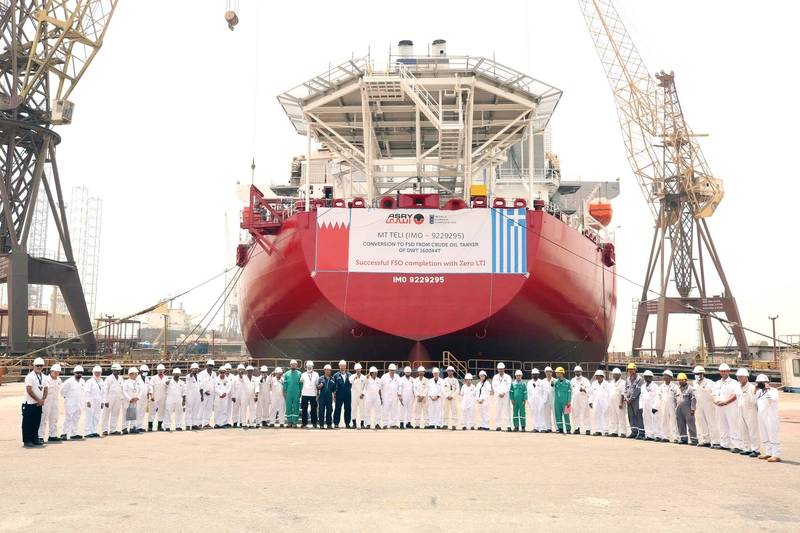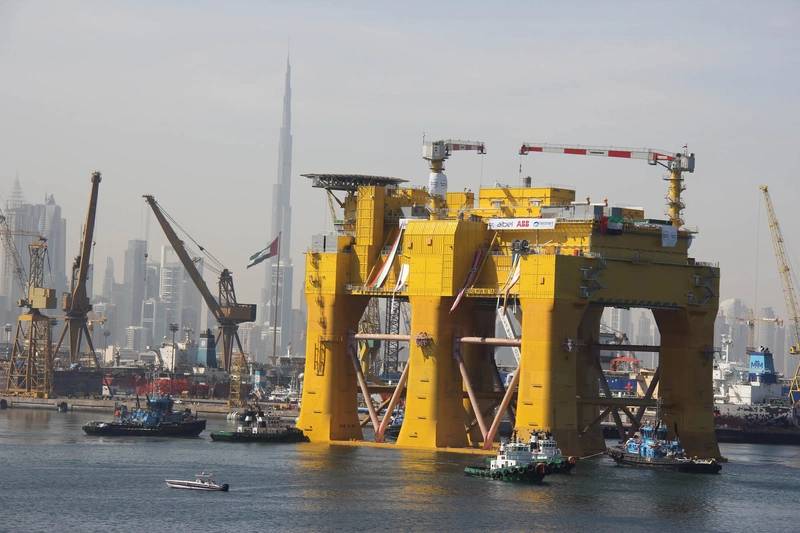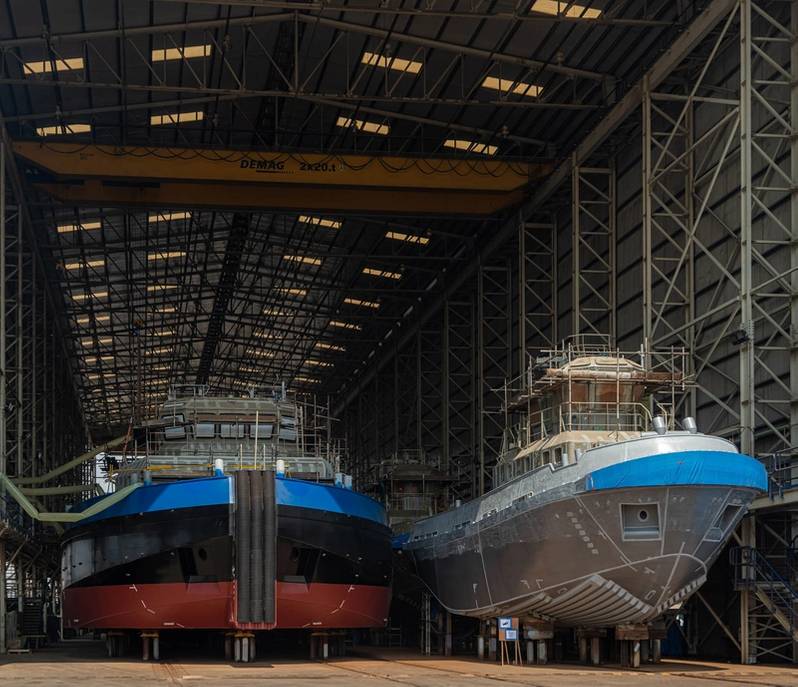Middle East Ship Repair Yards Remain Center Stage
In the 45 years since the Arab Shipbuilding & Repair Yard (ASRY) opened on reclaimed land in Bahrain, the Middle East has become one of the world’s ship repair hotspots. A broad range of shipyards now service both regional and global markets.
Regional yards have a ready market, with hundreds of offshore rigs working across the region together with the service ships that support them. Then there are thousands of tankers and gas carriers that arrive each year to load energy cargoes for far-flung destinations. The region’s repair yards are in steady demand for routine repairs, surveys, and conversion projects.
However, the backdrop is changing as the supply of ship repair capacity continues to increase. An entirely new generation of repair facilities has gained a foothold across the region, with yards now specializing in repairs across all sectors, as well as more complex conversion projects and others linked to renewable energy.
Willem Moelker is Sales & Marketing Director at Sharjah-based joint venture shipbuilder and repairer, Albwardy Damen. Speaking to Maritime Reporter recently, he described some recent regional repair developments. The recovery in oil prices has triggered a wave of new investment, he said, not only in oil and gas but also in civil infrastructure projects which themselves generate demand for workboats and service vessels.
 Image courtesy ASRY
Image courtesy ASRY
Carbon intensity climbs agenda
The drive for carbon reduction has now arrived in the Middle East, Moelker noted, partly in preparation for next year’s COP 28 in Dubai. Local owners are adapting, he said, highlighting a recent deal in which Albwardy Damen converted two DP2 platform support vessels to run on battery-assisted propulsion in a package supplied by Wärtsilä. Scope for sustainable energy projects both on land and sea are also climbing the agenda.
At its nine-year-old shipyard, built from scratch on arid land in Hamriyah Free Zone, Sharjah, Albwardy Damen undertakes repairs, conversions, and new construction. With service hubs in the busy bunkering port of Fujairah and its anchorage as well as Dubai Maritime City, the company offers a flexible one-stop-shop model. Specializing in smaller vessels, U.S. clients feature regularly on its books.
“We are well known by U.S.-based owners sailing in the region,” Moelker said. “On the repair side, we serve U.S.-based customers servicing both commercial as well as government-related assets. And we are currently constructing two Stan Tug 2308s for U.S.-based Tidewater. We also have a 260-foot Multibuster, an easily adapted multipurpose service vessel, on her way to a European owner for the renewable sector.”
At a regional level, rapidly expanding populations with high spending power are driving growth in container traffic from east and west. Meanwhile, Qatar’s massive LNG reserves have provided the basis for the world’s largest fleet of LNG carriers and the development of dedicated repair facilities to service them at Nakilat-Keppel Offshore Marine as well as a broad marine service sector in Ras Laffan.
Now, the country’s North Field development project will increase LNG exports by more than 40% from 2025. A large number of new LNG carriers are currently under construction for this vast project.
Meeting expectations
Shipyard sophistication across the region has accelerated to meet customer expectations. Leading yards report a growing volume of projects including conversions, upgrades and retrofits as owners tackle shipping’s digital and decarbonization challenges. Regular surveys and drydockings still provide foundation business, but more complex projects on ship, rigs, and renewable energy are increasingly important.
Executives at ASRY note that recent work scopes have included more complex projects, citing as an example the landmark conversion of the 2001-built Suezmax tanker, Cap Diamant, into a floating storage and offloading (FSO) vessel, MT Teli, ultimately for Houston-based Vaalco Energy. The successful project outcome, for the FSO’s operator in Greece, is thought likely to lead to other similar projects, managers said.
The 150-day conversion, completed in mid-2022, has enabled the Houston energy firm to reconfigure its setup at the Etame Marin field off the coast of Gabon. It has replaced BW Offshore’s FPSO, Petroleo Nautipa, and has radically altered the underlying economics.
Commenting on the project a few months ago, Vaalco’s CEO, George Maxwell, said: “This new FSO, which is scheduled to be online in September 2022, costs almost 50% less than the current FPSO and is expected to reduce our overall costs by approximately 17-20%. This will significantly improve our margins, enhance our cash flow generation, and sustain our operational excellence and robust financial performance at Etame through 2030.”
Meanwhile, U.S.-based Maersk Line has undertaken an innovative decarbonization project at ASRY. Container vessels have been modified to increase cargo capacity by 500 TEU. The project has cut carbon emissions significantly, yard sources report, and may lead to other similar projects.
 Offshore energy business powers a lot of repair and refit business in Middle East shipyards. Image courtesy Drydocks World
Offshore energy business powers a lot of repair and refit business in Middle East shipyards. Image courtesy Drydocks World
Importance of the U.S. market
Some 300 miles to the east lies Drydocks World, until recently the region’s largest repair yard. Executives there stress the importance of the U.S. market as a source of revenue generation. Recently completed projects at the Dubai yard include upgrades to some 20 offshore rigs, as well as the conversion of tankers to floating production storage and offloading (FPSO) units, and the retrofit and upgrade of vessels with various sustainable technologies.
Managers are currently in discussion with a major U.S.-based company on another FPSO conversion. And talks are under way on the shipyard’s possible involvement in various American projects, particularly off the country’s east coast, where renewable energy capacity is set to expand rapidly in the years ahead.
DDW has established a sound track record in the renewables sector. At the end of 2021, the shipyard delivered a 700MW topside, comprising worker accommodation and power grid processing equipment, for the Hollandse Kust Zuid wind farm in the Dutch sector of the North Sea. The facility is set to generate a total of 1,500MW of renewable energy, enough to meet the annual consumption of more than two million households in the Netherlands. The facility is scheduled to become fully operational later this year.
Other projects include the conversion of a ship into a crane vessel, Bokalift 2, in preparation for a range of offshore renewable energy projects. The project, which prepared the vessel for the installation of a 4,000-tonne Huisman Offshore Mast Crane, involved some 9,000 tonnes of new steel to increase stability, the creation of an 8,970 square yard working deck, and accommodation for 150 persons. The vessel is now deployed in the transport and installation of wind turbine foundations on the Changfang and Xidao wind farm in Taiwan.
A highlight of the shipyard’s sustainability drive was the 2022 signing of a partnership agreement with UK-based Silverstream Technologies to promote the use of air lubrication technology on existing vessels undergoing surveys and/or environmental upgrades. Silverstream boss, Noah Silberschmidt, has closed several substantial deals with ship operators recently and is now focusing on approved installation agreements with major repair yards of which DDW is a front-runner. The air lubrication technology has already been installed on various ship types including LNG carriers, roro ships, bulk carriers and cruise vessels.
At a corporate level, DDW is on track to become completely net-zero by 2040, according to yard executives. This endeavor is a clear sign of direction of travel, as the facility evolves from being a shipyard to becoming a pioneer in renewable energy construction. Meanwhile, the sustainability drive is evident in many aspects of the shipyard’s activities, with the notable example of a partnership with the Dubai Electricity and Water Authority to safeguard the marine environment at its shipyard sites.
 New construction, too. Image courtesy Albwardy Damen
New construction, too. Image courtesy Albwardy Damen
Rapid expansion
In addition to the many small yards and service facilities around the Gulf coast and notably the UAE, there are two other large facilities of note. Recent expansion at the recently rebranded Asyad Dry Dock in Duqm, Oman, has pitched the yard high on the region’s list of key players. Previously Oman Drydock Company, the shiprepairer’s new name reflects its ownership by Oman shipping and logistics group, Asyad. The facility has two graving docks with a capacity of up to 600,000dwt and 1.8 miles of quayside.
Further expansion at the shipyard complex is under way, with commissioning of a floating panamax dock due any time now. This is a timely development: the yard’s CEO Dr Ibrahim Al-Nadhairi recently revealed that Covid-related restrictions in South East Asia had generated new business opportunities for Middle East repairers as repair business moves west.
Meanwhile, in Saudi Arabia, the region’s largest repair and construction complex, International Maritime Industries (IMI), is ramping up operations. A joint venture between Saudi Aramco, Lamprell, Bahri, and Hyundai Heavy Industries, the vast complex has been built to undertake ship and offshore construction, repairs and all related business. The purpose-built facility is sited at Ras Al Khair on Saudi’s Gulf coast and already has an eye-watering forward book.
IMI holds newbuilding commitments worth $10 billion over 10 years with partners Aramco, 20 rigs, and Bahri, 52 vessels. And although the assets are destined for hydrocarbon-related business, the shipyard’s managers have adopted a strong ‘green’ strategy.
It aims to exceed local and global environmental compliance and to become an active contributor to the Saudi Green Initiative and UN Sustainable Development Goals. A key component of the strategy is ‘circularity’ – the four ‘R’s’ – Reduce, Reuse, Recycle, Recover. This will be achieved through various decarbonization initiatives including the development of renewable energy and the adoption of alternative fuel technology.
Earlier this year, IMI announced a tie-up with Columbia Ship Management to collaborate on ship design, construction, and repair. Through a MoA, the two companies now combine the region’s largest shipyard complex and a leading ship manager with services including vessel operation, crewing, training, and newbuilding and repair supervision.














